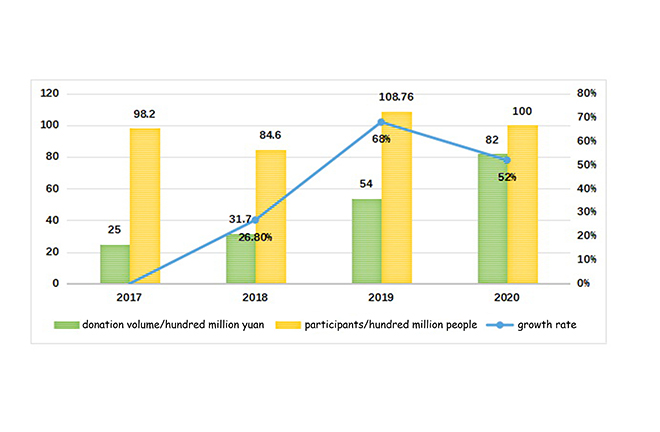Tertiary distribution fosters common prosperity

FILE PHOTO: The total donation volume in China in recent years
As the fostering of common prosperity has become an important issue in the modernization process of China’s national governance, the tertiary distribution, a channel that promotes common prosperity, has aroused extensive attention from all walks of life.
Complementary role
Generally speaking, common prosperity should require abundant materials which grow steadily as the premise. Therefore, it is inevitable to place the same premium on the distribution of “cake” as on how to make the “cake” continuously bigger.
Tertiary distribution is a stage of social wealth distribution in terms of national income. Overall, when social wealth is created, it is first distributed between workers, capital owners, and the government. Workers get paid, capital owners earn profits, and governments obtain taxes—this is known as the primary distribution. Since primary distribution should be beneficial to wealth creation and efficiency improvement, the market mechanism thus plays a leading role in the process.
Secondary distribution refers to allocating the financial funds gained from taxes and other channels in a rational way and improving institutional arrangements such as social security and transfer payments. The goal is that the fruits of reform and development can benefit all the people fairly. It is the basic method in which public power intervenes in the distribution of social wealth. Since a large part of financial funds benefit the people through the social security system, and the people’s transfer income mainly comes from different kinds of social security projects, social security plays the most important role in the secondary distribution.
Tertiary distribution mainly refers to philanthropic acts, such as individuals voluntarily donating money and supplies to charitable organizations and other social groups in need, or participating in a public welfare lottery so as to give back to society. Dominated by the moral power of the commonweal, tertiary distribution takes the form of mutual friendship and aid between social members.
Primary distribution represents the largest part in the whole distribution of social wealth in any given year. It is the most crucial because it decides the initial state of urban and rural residents’ income, and constitutes the basis of the social wealth distribution pattern. Secondary distribution is key since it constitutes another essential source of income for residents and plays a role in substantially narrowing the income gap caused by the primary distribution. Tertiary distribution takes a small share and can only play a complementary role in adjusting social wealth distribution. Therefore, it can be said that the tertiary distribution is conducted mainly for the purpose of utilizing its social values instead of adjusting the distribution in an economic sense.
Through tertiary distribution, the defects of primary and secondary distribution can be somewhat made up; and in this framework, those who get rich first may help late-comers. For example, after the outbreak of the COVID-19 pandemic, the money and goods donated by all sectors of society have effectively made up for the lack of governmental financial allocation and material reserves, which contributed to supporting the country’s anti-virus actions and helped ensure people’s livelihood. Another case in point is that some “online aid platforms” offered help to those diagnosed with fatal diseases by raising funds from individuals, which adjusts personal wealth in an effective way.
Problems remain
Charity is a social cause of commonweal based on donation. Fully utilizing the role of tertiary distribution can strongly underpin the development of charity. Tertiary distribution, in fact, constitutes the most important material basis for charity, but charity cannot simply be equated to the tertiary distribution. A social cause with public participation, charity in modern days is formed with personal donation as the core. However, participation from the government, market entities, and social forces is also indispensable.
With national-level encouragement and policy support, such as the implementation of the Laws on Donation for Public Welfare and the Charity Law, charity undertakings in China have continued to develop. However, compared with the expansion of middle- and high-income groups and the accelerating pace of personal wealth accumulation, the scale of the tertiary distribution is still quite limited.
The main reason for this situation is the lack of development momentum for charitable organizations themselves, their weak ability to mobilize resources, and more importantly, insufficient tax and financial support. In addition, auxiliary measures and accessories are not complete enough. Lottery funds for public welfare have likewise not become an important source of capital for boosting charities.
Strictly speaking, individuals are the major players of the tertiary distribution, which is the basic way for individuals to give back to society after obtaining legal income. However, in the current Chinese system of charity donation, enterprises are the chief players, and individual donations are in a subordinate role. To change this dissatisfactory situation, the key is to build a policy system that positively incentivizes individual donations. For instance, volunteer service in the charity sector can be included into the domain of social public service and therefore be measured. New tax categories, such as legacy duty and gift tax can be promulgated, which is conducive to fostering a benign social atmosphere in which everyone does good deeds.
Zheng Gongcheng is a professor from Renmin University of China and the director of the China Association of Social Security.
Edited by BAI LE
